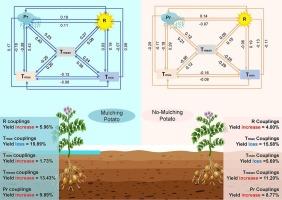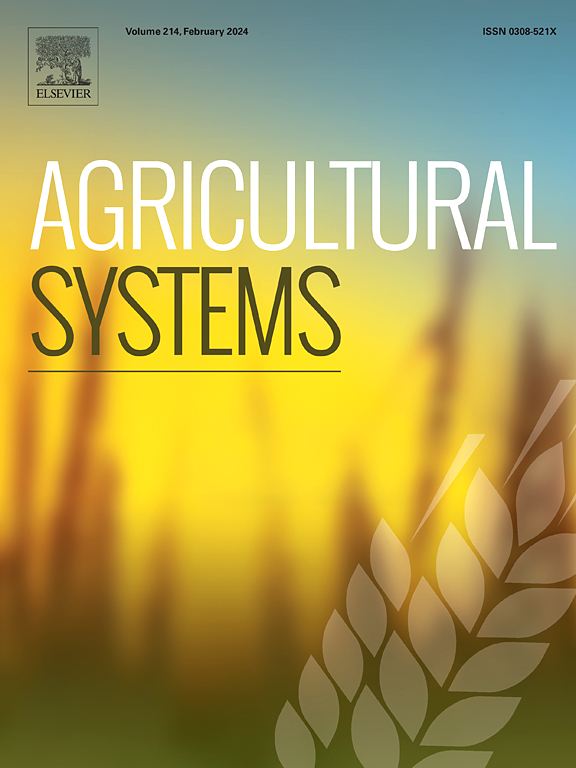Clarifying the impacts of climatic coupling on plastic-mulching potato production in the loess plateau of China
IF 6.1
1区 农林科学
Q1 AGRICULTURE, MULTIDISCIPLINARY
引用次数: 0
Abstract
Context
The ongoing changes in climate constitute a major risk factor for global potato production. Recent studies have underscored the productivity-enhancing effects of plastic mulching for rain-fed potatoes. However, the adaptability of mulching measures to climate change in order to facilitate increased potato yields remains a question. Moreover, the coupling effects of different climatic factors on potato production was unclear.
Objective
This study aimed to investigate the impact of different climatic factors and their coupling effects on the yields of mulching and no mulching potatoes in the Loess Plateau.
Methods
We utilized multiple crop models and global climate models (GCMs) to predict the yields of mulching and no mulching potatoes on the Loess Plateau based on Shared Socioeconomic Pathway (SSP) 245 and SSP585 scenarios. Additionally, we analyzed the response of yields to the coupling effects of climate, and clarified the effects of main climatic coupling effects to yield of mulching and no mulching potatoes.
Results and conclusions
We found that, for mulching potatoes, the contribution of climate coupling to yield under the SSP245 and SSP585 scenarios ranged from 47.05 % to 49.31 % for the period 2021–2060 and increased to 49.09 % to 50.94 % for the period 2061–2100. The mean temperature (Tmen)-dominated coupling contributed the most to yield for mulching potatoes, while for no mulching potatoes, precipitation (Pr)-dominated coupling played a dominant role. The maximum temperature (Tmax)-dominated coupling significantly reduced potato yields in the future, and mulching measures exacerbated the negative effect. However, mulching measures eliminated the adverse impact of minimum temperature (Tmin)-dominated coupling on potato yields. After decomposing the coupling effects of climatic factors, we found that the main factors leading to a reduction in potato yield were Tmax and Pr couplings, with mulching measures amplifying the heat-moisture effects. But mulching not only alleviated Tmin and Pr coupling but also strengthened the Tmean and Pr coupling, resulting in increased yield.
Significance
Hence, understanding how mulching potatoes avoid heat-moisture coupling to promote production was crucial for the future on the Loess Plateau. Our findings contribute to clarifying the impact of climatic coupling on mulching potato production, thereby aiding in the informed development of rational policies.

阐明气候耦合对中国黄土高原塑膜马铃薯生产的影响
背景持续的气候变化是全球马铃薯生产的一个主要风险因素。最近的研究强调了塑料地膜覆盖对雨养马铃薯的增产效果。然而,地膜覆盖措施能否适应气候变化以促进马铃薯增产仍是一个问题。本研究旨在探讨不同气候因素及其耦合效应对黄土高原地膜覆盖和无地膜覆盖马铃薯产量的影响。方法我们利用多种作物模型和全球气候模型(GCMs),根据共享社会经济路径(SSP)245和SSP585情景预测黄土高原地膜覆盖和无地膜覆盖马铃薯的产量。此外,我们还分析了产量对气候耦合效应的响应,明确了主要气候耦合效应对地膜马铃薯和无地膜马铃薯产量的影响。结果与结论我们发现,对于地膜马铃薯而言,在 SSP245 和 SSP585 情景下,气候耦合效应对产量的贡献率在 2021-2060 年期间为 47.05% 至 49.31%,在 2061-2100 年期间增至 49.09% 至 50.94%。平均温度(Tmen)为主的耦合对地膜覆盖马铃薯的产量贡献最大,而对无地膜覆盖马铃薯而言,降水(Pr)为主的耦合则起主导作用。以最高温度(Tmax)为主的耦合在未来会显著降低马铃薯产量,而地膜覆盖措施会加剧这种负面影响。然而,地膜覆盖措施消除了以最低温度(Tmin)为主的耦合对马铃薯产量的不利影响。在分解气候因子的耦合效应后,我们发现导致马铃薯减产的主要因素是Tmax和Pr耦合,而地膜覆盖措施放大了热湿效应。因此,了解马铃薯地膜覆盖如何避免热湿耦合以促进生产对黄土高原的未来至关重要。我们的研究结果有助于阐明气候耦合对地膜马铃薯生产的影响,从而帮助制定合理的政策。
本文章由计算机程序翻译,如有差异,请以英文原文为准。
求助全文
约1分钟内获得全文
求助全文
来源期刊

Agricultural Systems
农林科学-农业综合
CiteScore
13.30
自引率
7.60%
发文量
174
审稿时长
30 days
期刊介绍:
Agricultural Systems is an international journal that deals with interactions - among the components of agricultural systems, among hierarchical levels of agricultural systems, between agricultural and other land use systems, and between agricultural systems and their natural, social and economic environments.
The scope includes the development and application of systems analysis methodologies in the following areas:
Systems approaches in the sustainable intensification of agriculture; pathways for sustainable intensification; crop-livestock integration; farm-level resource allocation; quantification of benefits and trade-offs at farm to landscape levels; integrative, participatory and dynamic modelling approaches for qualitative and quantitative assessments of agricultural systems and decision making;
The interactions between agricultural and non-agricultural landscapes; the multiple services of agricultural systems; food security and the environment;
Global change and adaptation science; transformational adaptations as driven by changes in climate, policy, values and attitudes influencing the design of farming systems;
Development and application of farming systems design tools and methods for impact, scenario and case study analysis; managing the complexities of dynamic agricultural systems; innovation systems and multi stakeholder arrangements that support or promote change and (or) inform policy decisions.
 求助内容:
求助内容: 应助结果提醒方式:
应助结果提醒方式:


